*****The following article, by Lindsay Rowntree, appears as an online article in the News section on ExchangeWire’s web site and was originally published on April 20, 2017.
Much conversation over recent months has centered around brand safety, or lack thereof. How does the industry tackle brand safety and is it technically a ‘fixable’ issue? ExchangeWire speak with Jeff Finn (pictured below), CEO, zvelo, about how brand safety should be addressed and why brands accepting that brand safety comes at a cost is the starting point the industry needs.
ExchangeWire: The talk of the town is that ‘we must fix brand safety’ – how do we go about fixing it and what technical barriers exist?
Jeff Finn: Brand safety – or, rather, the failure to address brand safety – has come up many times over the last several years. It’s now front and centre due to a combination of factors that will hopefully drive the industry to finally take a comprehensive approach to the challenge. Unlike ad fraud, which is hidden from public view, brand safety is highly visible. Placing a brand’s ad next to the wrong or inappropriate content gets immediately noticed and is also exacerbated with the reach of social media – a bad brand experience can go viral in minutes. Brand safety has finally reached a tipping point that the industry can no longer ignore.
The fix to brand safety has to start with the brands themselves. No one other than the brand in the ad tech landscape is truly motivated to address brand safety, because doing so will result in reduced inventory, commissions, and fees by others. Brands must demand and enforce that brand safety be implemented platform-wide across the ad tech ecosystem, from the buy side to the sell side.
“In today’s brand safety world, no one loses other than the brands. With brand safety, no one wins other than the brands. So, it is up to brands to start the long-overdue revolution.”
That said, a comprehensive brand safety approach is not free and is also associated with considerable technical, people, and process challenges. More ads are being targeted at highly dynamic websites, blogging, news, and social media channels – places where content is not moderated. These types of advertising environments, which continually change (and can go from innocuous to virulent content in seconds), require a solution that performs real-time brand-safety detection and categorisation at a massive scale across dozens of languages for text, images, videos, slang, and more. Additionally, buy-side and sell-side platforms need to be able to ingest these massive raw data feeds to eliminate latency and meet the millisecond response times required for programmatic transactions. Also, fundamental changes to workflows and financial incentives for the buyers and sellers of online digital advertising will need to be implemented. These kinds of investments in the technology, the data, and the changes to behaviour and workflow will only take place when brands force the issue. Read more.





